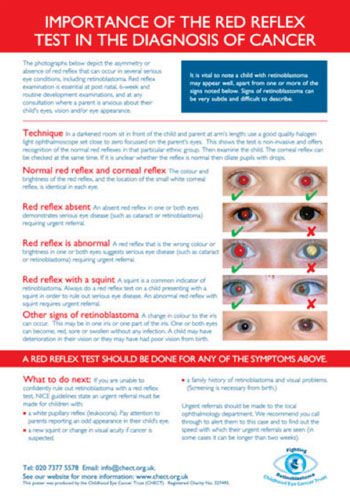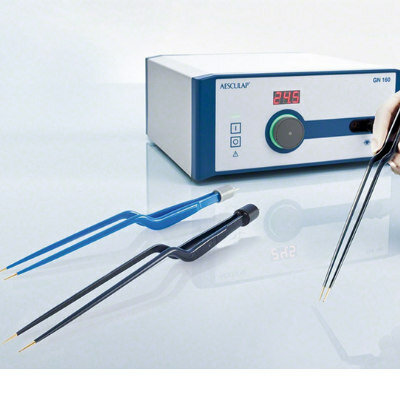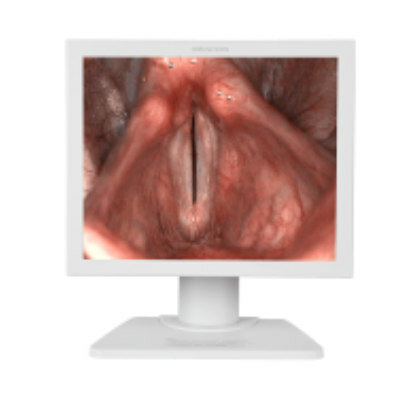Red Reflex Test Helps Rule Out Retinoblastoma
|
By HospiMedica International staff writers Posted on 03 Jun 2014 |

Image: The CHECT Red Reflex Poster – link provided below (Photo courtesy of CHECT).
General Practitioners (GPs) in the United Kingdom are being urged to ensure every squint is checked to rule out eye cancer.
The Childhood Eye Cancer Trust (CHECT; London, United Kingdom) is urging that all squints in babies and young children be checked with a red reflex test to exclude a diagnosis of retinoblastoma (Rb). As squints are common in babies up to the age of three months, the only way to determine whether this is a sign of a much more serious condition is to carry out the test, a noninvasive procedure that involves looking in the eye with a hand-held ophthalmoscope.
To promote this message, CHECT has developed e-cards and an email campaign that GPs can share and forward on to colleagues. The campaign asks that particular attention be paid to children with a recently onset squint; a white pupillary reflex (leukocoria); an abnormal reflex in photographs taken with a flash; a change in color of the iris; or a deterioration in vision. According to figures released by CHECT, 26% of babies and young children diagnosed with Rb presented with a squint, which is the second most common symptom of the disease (after leukocoria).
“In our experience, some babies and young children are facing serious delays in receiving life-saving treatment as a result of parents either being told incorrectly that their baby's squint is completely normal, or being given a non-urgent squint referral,” said Joy Felgate, CEO of CHECT. “If you are unable to confidently rule out retinoblastoma with a red reflex test, NICE guidelines state an urgent referral must be made to the local ophthalmology department stating 'suspected retinoblastoma.'”
Retinoblastoma is a fast-growing cancer that develops from the immature cells of a retina, affecting mainly children up to five years of age. Early detection of this aggressive condition is crucial to offer the child the best chance of saving their vision, their eyes, and their life. There are two forms of the disease, a heritable form and nonheritable form; about 55% of children with Rb have the nonheritable form. In about two thirds of cases, only one eye is affected (unilateral retinoblastoma); in the other third, tumors develop in both eyes.
Related Links:
Childhood Eye Cancer Trust
CHECT Red Reflex Poster
The Childhood Eye Cancer Trust (CHECT; London, United Kingdom) is urging that all squints in babies and young children be checked with a red reflex test to exclude a diagnosis of retinoblastoma (Rb). As squints are common in babies up to the age of three months, the only way to determine whether this is a sign of a much more serious condition is to carry out the test, a noninvasive procedure that involves looking in the eye with a hand-held ophthalmoscope.
To promote this message, CHECT has developed e-cards and an email campaign that GPs can share and forward on to colleagues. The campaign asks that particular attention be paid to children with a recently onset squint; a white pupillary reflex (leukocoria); an abnormal reflex in photographs taken with a flash; a change in color of the iris; or a deterioration in vision. According to figures released by CHECT, 26% of babies and young children diagnosed with Rb presented with a squint, which is the second most common symptom of the disease (after leukocoria).
“In our experience, some babies and young children are facing serious delays in receiving life-saving treatment as a result of parents either being told incorrectly that their baby's squint is completely normal, or being given a non-urgent squint referral,” said Joy Felgate, CEO of CHECT. “If you are unable to confidently rule out retinoblastoma with a red reflex test, NICE guidelines state an urgent referral must be made to the local ophthalmology department stating 'suspected retinoblastoma.'”
Retinoblastoma is a fast-growing cancer that develops from the immature cells of a retina, affecting mainly children up to five years of age. Early detection of this aggressive condition is crucial to offer the child the best chance of saving their vision, their eyes, and their life. There are two forms of the disease, a heritable form and nonheritable form; about 55% of children with Rb have the nonheritable form. In about two thirds of cases, only one eye is affected (unilateral retinoblastoma); in the other third, tumors develop in both eyes.
Related Links:
Childhood Eye Cancer Trust
CHECT Red Reflex Poster
Latest Critical Care News
- CPR Guidelines Updated for Pediatric and Neonatal Emergency Care and Resuscitation
- Ingestible Capsule Monitors Intestinal Inflammation
- Wireless Implantable Sensor Enables Continuous Endoleak Monitoring
- Pulse Oximeter Index Offers Non-Invasive Guides for Fluid Therapy
- Wearable Patch for Early Skin Cancer Detection to Reduce Unnecessary Biopsies
- 'Universal' Kidney to Match Any Blood Type
- Light-Based Technology to Measure Brain Blood Flow Could Diagnose Stroke and TBI
- AI Heart Attack Risk Assessment Tool Outperforms Existing Methods
- Smartphone Imaging System Enables Early Oral Cancer Detection
- Swallowable Pill-Sized Bioprinter Treats GI Tract Injuries

- Personalized Brain “Pacemakers” Could Help Patients with Hard-To-Treat Epilepsy
- Microscopic DNA Flower Robots to Enable Precision Medicine Delivery
- Origami Robots to Deliver Medicine Less Invasively and More Effectively
- Improved Cough-Detection Technology Aids Health Monitoring
- AI Identifies Children in ER Likely to Develop Sepsis Within 48 Hours
- New Radiofrequency Therapy Slows Glioblastoma Growth
Channels
Surgical Techniques
view channel
Robotic Assistant Delivers Ultra-Precision Injections with Rapid Setup Times
Age-related macular degeneration (AMD) is a leading cause of blindness worldwide, affecting nearly 200 million people, a figure expected to rise to 280 million by 2040. Current treatment involves doctors... Read more
Minimally Invasive Endoscopic Surgery Improves Severe Stroke Outcomes
Intracerebral hemorrhage, a type of stroke caused by bleeding deep within the brain, remains one of the most challenging neurological emergencies to treat. Accounting for about 15% of all strokes, it carries... Read morePatient Care
view channel
Revolutionary Automatic IV-Line Flushing Device to Enhance Infusion Care
More than 80% of in-hospital patients receive intravenous (IV) therapy. Every dose of IV medicine delivered in a small volume (<250 mL) infusion bag should be followed by subsequent flushing to ensure... Read more
VR Training Tool Combats Contamination of Portable Medical Equipment
Healthcare-associated infections (HAIs) impact one in every 31 patients, cause nearly 100,000 deaths each year, and cost USD 28.4 billion in direct medical expenses. Notably, up to 75% of these infections... Read more
Portable Biosensor Platform to Reduce Hospital-Acquired Infections
Approximately 4 million patients in the European Union acquire healthcare-associated infections (HAIs) or nosocomial infections each year, with around 37,000 deaths directly resulting from these infections,... Read moreFirst-Of-Its-Kind Portable Germicidal Light Technology Disinfects High-Touch Clinical Surfaces in Seconds
Reducing healthcare-acquired infections (HAIs) remains a pressing issue within global healthcare systems. In the United States alone, 1.7 million patients contract HAIs annually, leading to approximately... Read moreHealth IT
view channel
Printable Molecule-Selective Nanoparticles Enable Mass Production of Wearable Biosensors
The future of medicine is likely to focus on the personalization of healthcare—understanding exactly what an individual requires and delivering the appropriate combination of nutrients, metabolites, and... Read moreBusiness
view channel
Philips and Masimo Partner to Advance Patient Monitoring Measurement Technologies
Royal Philips (Amsterdam, Netherlands) and Masimo (Irvine, California, USA) have renewed their multi-year strategic collaboration, combining Philips’ expertise in patient monitoring with Masimo’s noninvasive... Read more
B. Braun Acquires Digital Microsurgery Company True Digital Surgery
The high-end microsurgery market in neurosurgery, spine, and ENT is undergoing a significant transformation. Traditional analog microscopes are giving way to digital exoscopes, which provide improved visualization,... Read more
CMEF 2025 to Promote Holistic and High-Quality Development of Medical and Health Industry
The 92nd China International Medical Equipment Fair (CMEF 2025) Autumn Exhibition is scheduled to be held from September 26 to 29 at the China Import and Export Fair Complex (Canton Fair Complex) in Guangzhou.... Read more













